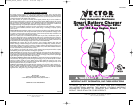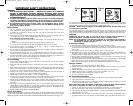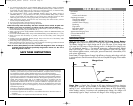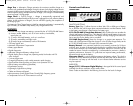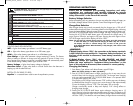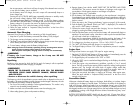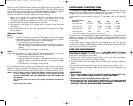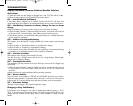
9
APPROXIMATE CHARGING TIMES
The
50/30/15/4 Amp Smart Battery Charger
will automatically adjust the
charge rate as the battery becomes charged and stop when the battery is fully
charged. Deep cycle batteries may require longer charging time.
For estimates of the time it takes to charge a 12 volt battery, refer to the following
table.
Percent of charge
in battery 75% 50% 25% 0%
at 4 amp rate 3.5 HRS 7 HRS 10.5 HRS 14 HRS
at 15 amp rate 1 HR 2 HRS 2.8 HRS 3.7 HRS
at 30 amp rate NR* 1 HR 1.4 HRS 1.9 HRS
at 50 amp rate NR* NR* NR* NR*
* Not recommended for charging batteries less than 80 Ah
The times shown in the table above are approximate and refer to a 50 Ah automotive
battery. For example, a 50 Ah (12 volt) battery is discharged (50%). How long
should it be charged at the 15 amp rate? See the chart above under “50%” and “at
15 amp rate.”
In most cases, battery charging times will vary depending on the size, age and
condition of the battery. Smaller batteries should be charged at a lower rate (4 amps)
and an extra hour added to charge time.
CARE AND MAINTENANCE
With proper care and minimal maintenance, the
VEC1098A 50/30/15/4 Amp
Smart Battery Charger
will provide years of dependable service. For maximum
performance, manufacturer recommends:
• After each use, clean the battery charger clamps — be sure to remove any battery
fluid that will cause corrosion of the copper clamps.
• Clean the outside case of the charger with a soft cloth and, if necessary, mild soap
solution.
• Do not allow liquid to enter the charger. Do not operate when charger is wet.
• Keep the charger cords loosely coiled during storage to prevent damage to the
cords.
WARNINGS
• Do not use charger if cords or clamps have been damaged in any
way — call Technical Support toll-free at (800) 544-6986.
• There are no user-serviceable parts in this unit.
• Do not open the unit. In the event of malfunction, it must be returned
to manufacturer for professional testing and repair. OPENING THE
UNIT WILL VOID THE MANUFACTURER’S WARRANTY.
8
before using RECONDITION Mode. Observe the Digital Display for any codes. This
initial charge will check the battery for shorted cells (F01), open cells (F03) or battery
too low to accept a charge (F02), and to ensure the battery can take a charge. If
code (F03) is displayed, change to the BATTERY RECONDITION MODE.
Remove or disconnect the vehicle’s battery when reconditioning.
1. Make sure the charger is in initiation state with a circulating pattern on the
display or in charge OFF mode with “000” on the display. If not, press
4/15/30/50 AMP button repeatedly until “000” shows on the display.
2. Press the Battery Recondition button to start the process.
3. DES appears on the display for 3 seconds, then it changes to three horizontal
moving bars.
4. The process takes 24 hours and stops automatically. The display shows “000”
when complete.
Alternator Check
Part 1
No Load (Turn OFF all vehicle’s accessories): The battery must be fully charged
before testing the alternator. Run the engine long enough to achieve
normal idle speed and verify there is a no-load voltage.
1. Press Alternator Check to start the test.
2. Alternator Good LED will light to indicate the alternator is good, or
F07 will display to indicate the alternator is out of typical operation
voltage.
3. Press Alternator Check again to stop the test.
Part 2
Under Load (Accessories on): Next, load the alternator by turning on as many
accessories as possible (except for A/C and DEFROST)
1. Press Alternator Check to start the test.
2. Alternator Good LED will light to indicate the alternator is good, or
F07 will display to indicate the alternator is out of typical voltage
range.
3. Press Alternator Check again to stop the test.
If the first alternator check indicates a good alternator and the second indicates the
alternator is bad, the problem could stem from: loose fan belts, an intermittent diode
failure or possibly bad connections between the battery and alternator and/or ground.
Notes: F07 may display because someone has added a number of accessory loads
on the charging system, thereby increasing current demand from the
alternator. MAKE SURE THAT THE ALTERNATOR IS RATED TO SUPPORT THE
APPLICATION.
This check may not be accurate for every make, manufacturer and model of
vehicle.
Check only 12 volt systems.
VEC1098A_Manual_082606 8/26/06 12:56 PM Page 8



